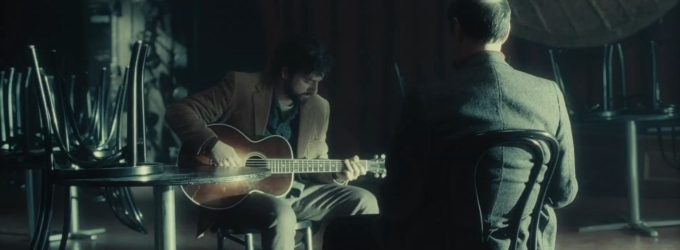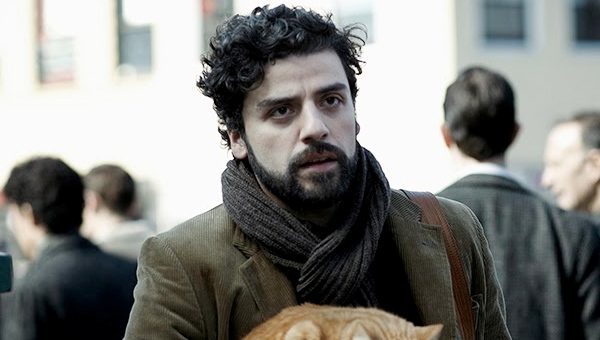 After the straightforward Western adventure of TRUE GRIT, the Coen brothers’ latest film circles back to some of their well-trodden themes. It has the existential malaise of 2009’s A SERIOUS MAN, and in its focus on a put-upon creative type it bears some resemblance to BARTON FINK.
After the straightforward Western adventure of TRUE GRIT, the Coen brothers’ latest film circles back to some of their well-trodden themes. It has the existential malaise of 2009’s A SERIOUS MAN, and in its focus on a put-upon creative type it bears some resemblance to BARTON FINK.
Oscar Isaac plays that creative type, a folk singer named Llewyn Davis in early-60s New York. He’s in a rut, professionally and personally; sleeping on friends’ couches, getting by on the odd gig or recording session, hoping that his music will catch someone’s ear. (Isaac is a trained musician, and the Coens make the most of his talent during the electrifying performances.) His former musical partner has recently committed suicide, which leaves his musical career in a strange kind of half-life; trying to make it as a solo act, while the legacy of the former duo hangs over him.
Most of the relationships in his life, professional and personal, are fraught with conflicts that bubble along rather than boiling over. His friend Jean (a refreshingly hard-boiled Carey Mulligan) is pregnant, possibly by Llewyn, possibly by her partner Jim (Justin Timberlake). He has to ask Jim for the money to pay for an abortion, but without letting him know what it’s for. He constantly needs money, a place to stay, basic guarantees of stability.
He’s pushed this way and that; mocked, shouted at, abandoned, beaten up in an alleyway. But then, he’s not an easy character to like. Prickly, judgemental and selfish, he’s basically “an asshole”, as Jean dubs him. But somehow you can’t help but root for him to get out from underneath his numerous problems.
The nature of all the trials faced by our protagonist is summed up in the cat that escapes from the apartment of the Gorfeins, an Upper East Side liberal Jewish academic couple who offer Llewyn a bed for the night. As most cats are, it’s capricious, solitary and fiercely independent – much like Llewyn himself. Llewyn hunts for it high and low all over the city, running into it (or various look-alikes) throughout the film. When the cat’s name is revealed as Ulysses, it’s a nice callback to O BROTHER, WHERE ART THOU?, the Coens’ comic take on Homer’s Odyssey, and their other movie featuring numerous musical performances.
There’s a suggestion that Llewyn is just missing that crucial something – he’s talented, but talent only gets you so far
Like George Clooney’s Ulysses Everett McGill in O BROTHER (and his mythical namesake), Llewyn is also a wanderer, but one without any clear destination. His family home is about to be sold, and he drifts from spare bed to couch among the small circle of friends still willing to put him up (and put up with him). This episodic nature counts against the film; it’s a series of vignettes, more like an EP than a unified suite of songs.
Predictably, it’s a beautiful-looking film. Cinematographer Bruno Delbonnel, filling in for the Coens’ regular collaborator Roger Deakins, shoots New York and the rural Midwest with a wintery chill, outfitted in a relentlessly monotonous palette of browns, beige and greys.
There are also some excellent cameos. F. Murray Abraham makes the most of his few scenes as a vaguely intimidating club promoter who Llewyn tries to woo with a personal audition (his brutal assessment: “I don’t see a lot of money here”). Coens regular John Goodman is on excellent form as the heroin-addicted jazz musician accompanying Llewyn on a disastrous road trip to Chicago for said audition. He’s either on the nod or in full splenetic flow, mocking Llewyn, rapping him with his cane and threatening him with “what squares like you would refer to as the dark arts”. But the film is truly Isaac’s. He’s more or less in every scene, and frequently seen in mid-length or long shots; a lonely figure, struggling through the endless cold in his thin corduroy jacket.
As much as Llewyn talks about his notion of “authenticity”, he’s not above performing with Jim on a ludicrous novelty song titled “Please Mr Kennedy” (in the funniest scene of the film) for a quick paycheck. But his hard-luck struggles give him a certain nobility. There’s a note of sour irony in Llewyn’s failed attempt to rejoin the merchant navy being immediately followed by a scene at the Gaslight where he watches a group of clean-cut singers in cable-knit jumpers crooning old sea shanties.
There’s a suggestion that Llewyn is just missing that crucial something – he’s talented, but talent only gets you so far, and bad luck and indifference can wear down even the most committed. Or maybe he’s just in the right place at the wrong time; a cheeky nod to the 1960s folk scene’s most famous figure in the film’s closing minutes suggests that Llewyn’s story takes place in the moments before everything changed.
And it’s this tension that the Coens sustain across the film – between art and commerce, beatniks and late-60s counterculture, space race optimism and Vietnam-era disillusionment – that makes it such a fascinating object; never falling one way or the other but existing in a state of ambiguity, like the silence after the last note plays.
httpvh://youtu.be/fmyglO2Zr0E

